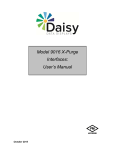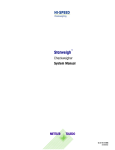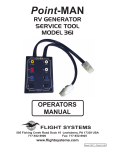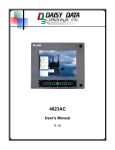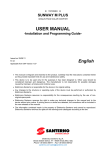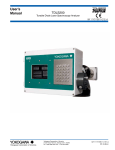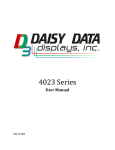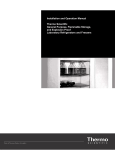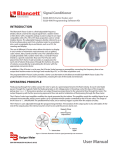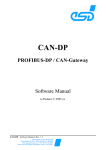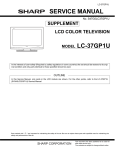Download Model 9017 Z/Y-Purge Interface: User`s Manual
Transcript
Model 9017 Z/Y-Purge Interface: User’s Manual October 2015 Model 9017 Z/Y-Purge Operator Interface DISCLAIMER Daisy Data Displays, Inc. (DAISY) makes no representations or warranties with respect to the contents or use of this manual, and specifically disclaims any express or implied warranties of merchantability or fitness for any particular purpose. Further, Daisy Data Displays, Inc. reserves the right to revise this publication and to make changes to its content, at any time, without obligation to notify any person or entity of such revisions or changes. Further, Daisy Data Displays, Inc. makes no representations or warranties with respect to any DAISY manufactured equipment, and specifically disclaims any express or implied warranties of merchantability or fitness for any particular purpose. Further, DAISY reserves the right to make changes to any and all DAISY manufactured equipment, at any time, without obligation to notify any person or entity of such changes. FCC WARNING Computing devices and peripherals manufactured by DAISY generate, use, and can radiate radio frequency energy, and if not installed and used in accordance with the instructions in this manual may cause interference to radio communications. Such equipment has been tested and found to comply with the limits for a Class A computing device pursuant to Subpart J of Part 15 of the FCC Rules, which are designed to provide reasonable protection against radio interference when operated in a commercial environment. Operation of this equipment in a residential area is likely to cause interference, in which case the user - at his own expense - will be required to take whatever measures may be required to correct the interference. Some components may not have been manufactured by Daisy Data Displays, Inc. If not, DAISY has been advised by the manufacturer of the component that the component has been tested and complies with the Class A computing device limits as described above. Copyright 2012 Daisy Data Displays, Inc. All rights reserved. No part of this publication may be reproduced, photocopied, stored on a retrieval system, or transmitted without express prior written consent. Daisy Data Displays, Inc. 2850 Lewisberry Road York Haven, PA 17370 USA Phone: (717) 932-9999 www.makeitdaisy.com October 2015 Edition Manual Revision 2.5 Part Number D011-000002 October 2015 ii Daisy Data Displays, Inc. Model 9017 Z/Y-Purge Operator Interface Limited Warranty and Liability Statement To the original purchaser, Daisy Data Displays, Inc., hereinafter referred to collectively as SELLER, warrants each of its manufactured products, and all components therein contained to be free from defects in materials and/or workmanship for a period of 12 months from the date of purchase. Should a malfunction or other indication of defect attributable directly to faulty materials and/or workmanship occur, Seller will, at its option, and without charge to the customer for labor and parts, repair or replace the defective product, F.O.B. Seller’s plant, but Seller will not be responsible for freight from Purchaser to Seller’s plant. In no event shall Seller be liable for any loss, inconvenience or damage, whether direct, incidental, consequential or otherwise resulting from abuse, misapplication or modification of the product, improper or faulty power, damage resulting from repairs or alterations performed by unauthorized persons, or conditions resulting from any other equipment attached to the product. Seller assumes no liability for damage occurring in transit due to the product not being returned in its original shipping material. This warranty is exclusive and is in lieu of any warranty of merchantability or fitness for a particular purpose or other warranty of quality whether expressed or implied, except of title and against patent infringement. Correction of nonconformities, in the manner and for the period of time provided above, shall constitute fulfillment of all liabilities of the Seller to the Purchaser with respect to, or arising out of the goods, whether based on contract, negligence, strict tort or otherwise. LIMITATION OF LIABILITY: The Seller shall not under any circumstances be liable for special or consequential damages, such as, but not limited to, damage or loss of other property or equipment, loss of profits or revenues, cost of capital, cost of purchased or replacement goods, or claims of customers of Purchaser for service interruptions. The remedies of the Purchaser set forth herein are exclusive, and the liability of Seller respect to any contract, or anything done in connection therewith such as the performance or breach thereof, of from the manufacture, sale, delivery, resale, installation or use of any goods covered by or furnished under this contract whether arising out of contract, negligence, strict tort or breach of warranty or otherwise, shall not, except as expressly provided herein, exceed the price of the goods upon which such liability is based. This warranty gives you specific legal rights, and you may also have other rights, which vary from state to state. Seller makes every effort to provide clear and accurate technical information on the application of its products in the Operator's Manual, and assumes no liability for misuse of the information. October 2015 iii Daisy Data Displays, Inc. Model 9017 Z/Y-Purge Operator Interface TABLE of CONTENTS Model 9017 Z/Y-Purge ................................................................................................................. 1 User’s Manual ............................................................................................................................... 1 DISCLAIMER....................................................................................................................................................... ii FCC WARNING ................................................................................................................................................... ii Limited Warranty and Liability Statement ........................................................................................................... iii TABLE of CONTENTS ........................................................................................................................................iv 1 Introduction ............................................................................................................................. 1 2 Hazardous Area Safety Methods: Theory of Operation ..................................................... 2 2.1 Division 1: Z/Y-Purge Protection ....................................................................................... 2 3 Pre-Installation Testing .......................................................................................................... 3 3.1 Division 1 Z-Purge Test ...................................................................................................... 3 4 Installation ............................................................................................................................... 5 4.1 Power and Signal Wiring Requirements ............................................................................. 5 4.2 Pack-Seal Connection Instructions ..................................................................................... 6 4.3 Purge Air Line Connection Instructions ............................................................................. 7 4.3.1 For Division 1 Z-Purge Systems Model 9017 .......................................................................................7 5 Start-Up Operation ................................................................................................................. 9 5.1 Division 1 Z/Y-Purge Start-Up Operation .......................................................................... 9 6 Operation Notes .................................................................................................................... 11 6.1 Division 1 Z-Purge ............................................................................................................ 11 7 Customer Service .................................................................................................................. 12 8 Trouble-Shooting Guide ....................................................................................................... 13 8.1 Division 1 Z-Purge Trouble-Shooting .............................................................................. 13 9 Specifications ......................................................................................................................... 15 10 Drawings .......................................................................................................................... 16 October 2015 iv Daisy Data Displays, Inc. Model 9017 Z/Y-Purge Operator Interface 1 Introduction Thank you for selecting a DAISY solution for your hazardous area operator interface requirements! This manual describes the general procedures for installing and operating DAISY Z/YPurge systems. The text portion of the manual also includes an overview of the theory behind the methods used to make electronic systems safe for hazardous areas. Section 9, Specifications, also contains an overview of system specifications, and Section 10, Drawings, includes mechanical drawings of each unit. We are always working to improve our documentation. If you have any suggestions or requests, please forward them to our sales department at [email protected], or to Daisy Data Displays, Inc., 2850 Lewisberry Road, York Haven, PA 17370, Attn: User Manual Coordinator. October 2015 1 Daisy Data Displays, Inc. Model 9017 Z/Y-Purge Operator Interface 2 Hazardous Area Safety Methods: Theory of Operation 2.1 Division 1: Z/Y-Purge Protection The Z-Purge (Model 9017) and the Y-Purge (DAISY Enclosure Mounted) Systems are Electrically and Pneumatically the same. For the rest of this manual they will refer to as a ZPurge. The I033-000002-03 Printed Circuit Board will be called the ZPA Assembly. Z-purge systems are used for installing electrical equipment in hazardous areas (see National Electrical Code articles 500-504 and the NFPA 496, section 2-8). A Z-purge system provides the protective purge and maintenance of safe gas flow to the enclosure; the purge system operation and the power and signal connections are controlled by the operator (as opposed to the automatic control provided by X-purge systems Model 9016). The purge system includes alarm contacts and a visible indicator to alert the user and possibly an automated control system in the event of the loss of pressure within the enclosure; that is, a failure of the protective safe gas flow or of enclosure integrity. At start-up, the enclosure is purged of any possible flammable materials by applying a rapid flow of air through the enclosure. Prior standards simply required an exchange of four volumes of air through the enclosure. However, the standards now require that the volume of air passed through a given enclosure eliminate any possible flammable concentration of substances within the enclosure (the minimum of four volumes of exchange still applies). Factory Mutual Class Number 3620 (section 4.2, page 5) states, “When … concern exists that all compartments may not be purged, purging tests shall be conducted.” This requires consideration not only of the airflow and pressure, but also of the enclosure’s shape and the effect of equipment installed within the enclosure. DAISY’s systems have been fully tested under the supervision of Factory Mutual to ensure compliance with the standards of FM 3620: 4.2. After the enclosure has been purged, the operator switches the purge control to the “operate” setting. At this setting, the air flow rate is reduced to conserve the protective gas while still maintaining a positive pressure within the enclosure to prevent the entry of flammable materials. At this time, the operator can apply power to the electronics within the enclosure. In the event of a loss of protective pressure within the enclosure, the alarm system will indicate the failure. The operator must then shut off power and signal connections at a safe disconnect location. Y-purge systems are used for installing electrical equipment in Division 1 hazardous areas (see National Electrical Code articles 500-504 and the NFPA 496, section 2-9). Essentially, the installation of a Y-purge on a DAISY enclosure in a Division 1 area reduces the rating inside of the enclosure to Division 2. This allows less costly Division 2 electronic equipment to be safely used in Division 1 areas. October 2015 2 Daisy Data Displays, Inc. Model 9017 Z/Y-Purge Operator Interface 3 Pre-Installation Testing Before installing your system in its final location, you may wish to test it to verify that the purge system is functioning correctly. 3.1 Division 1 Z-Purge Test IMPORTANT NOTE: Pre-installation testing should always be conducted in a safe area. Equipment Required • Clean, dry purge air or inert gas supply equipped with local water/oil separator or filter capable of supplying 150 SCFH at 20 - 100 PSI • Fittings and tubing for purge air or inert gas supply (0.25” NPT Male to connect to the inlet of the purge system) • Local air pressure shutoff valve Procedure 1. Place the unit in a safe area near a source of the purge gas to be used (compressed air line or other inert gas source). 2. Through a cord grip or other cable-sealing device, bring AC power into the enclosure. Be sure that the AC power is off. Connect the AC power temporarily to the Z-purged unit (see drawing E009 at the end of this manual). 3. Temporarily install a pressure regulator, water/oil separator or filter, shutoff valve, pressure relief valve, and pressure gauge in the purge air or inert gas line (see drawing P015 at the end of this manual.). 4. Bleed the purge air or inert gas line to insure that dirt, moisture, and other contaminants are cleared from the line prior to connecting the line to the unit! 5. Connect the purge gas line to the inlet of the regulator on the Purge Unit. 6. Apply air or inert gas to the enclosure. The enclosure may “swell” slightly as the internal pressure increases. This is normal and is not a cause for concern. DAISY enclosures are designed to release excess pressure. DO NOT ATTEMPT TO OPEN THE ENCLOSURE WHILE IT IS PRESSURIZED! 7. Turn the control valve to PURGE. Look at the flow meter on the front panel to verify that the flow rate is 150 SCFH. If not, readjust the purge regulator to set the flow to 150 SCFH. 8. If the flow meter does not read 150 SCFH, inspect the enclosure for blockage in the purge gas lines and take appropriate action to clear the blockage. If blockages are not obvious, verify that the purge air or inert gas is clean and dry. 9. Slowly turn the control valve to OPERATE. If the control valve is turned rapidly, the indicator ball in the flow meter may start oscillating. Look at the pressure gauge on the front panel to be certain that the internal pressure is 1.0” of Water Column. If not, reset the adjustment on the exhaust assembly on the so that the pressure gauge reads 1.0” of Water Column. 10. Slowly turn the control valve to PURGE. Make sure that the flow meter reads 150 SCFH. If not, readjust the regulator for 150 SCFH. 11. Slowly return the control valve to OPERATE and apply power to the enclosure. The “Pressure Good” LED should be illuminated green. If not, check the internal pressure, it October 2015 3 Daisy Data Displays, Inc. Model 9017 Z/Y-Purge Operator Interface should be between 0.4” and 10.0” of Water Column. The pressure good led must be illuminated green at this time. If it is not, please consult the factory. 12. If the “Pressure Good” LED is not illuminated green, the internal pressure is below 0.4” Water Column and the alarm is on. Turn the enclosure power off and repeat steps 2 though 6. October 2015 4 Daisy Data Displays, Inc. Model 9017 Z/Y-Purge Operator Interface 4 Installation 4.1 Power and Signal Wiring Requirements Mounting Location When mounting, Human Machine Interfaces (HMI) and Purge systems must be positioned to avoid radiated and induced interference. Do not mount the unit in close proximity to a device that generates strong radiofrequency interference or electromagnetic interference. HMI and Purge systems must be also positioned to avoid exposure to excessive heat. Do not mount the unit in close proximity to a steam line, heated vat or oven. Gland Plates Before modifications can be made, Gland Plates must be removed. Please note that metal shavings are detrimental to electronic systems. Machining Only make enclosure penetrations in designated locations. All metal shavings must be collected and removed. Wiring Requirements AC power inputs require dedicated circuits or feeds. Power from lines or circuits shared by motors, drives, welders, arc furnaces, or inductive lighting is not acceptable. Conduits for HMI and Purge power should be separated from other conduits to prevent radiated or induced interference. Devices that produce spikes, surges, and brownouts are detrimental to computers, and can corrupt data and interfere with purging systems. Do not use a transformer or other device to step down a three phase circuit to run a HMI or Purge System. Communication wires and signals should be run in separate conduits and routed away from power conduits. Providing isolation to prevent emissions from other conduits is essential to data integrity. Long runs of parallel signal lines can cause “cross-talk” and corrupt data making communications unreliable or impossible. DC power should be provided by a dedicated power source. If multiple units must be powered from a single DC supply, the power cables must be run directly from the unit to the supply. Chaining power from one unit to the next is unacceptable. Units can interfere with each other by developing noise due to the resistance of the wires. The filtering is provided by the source or power supply. Additional Wiring It is not permitted to run wiring through the unit that is nonessential to the unit. The cabinet is not a junction box. Adding Additional Equipment Installing additional equipment in units approved for hazardous classed environments violates the approval of the unit. October 2015 5 Daisy Data Displays, Inc. Model 9017 Z/Y-Purge Operator Interface 4.2 Pack-Seal Connection Instructions A conduit seal is necessary for most equipment enclosures in hazardous areas. For Zpurge, they are always required. Please consult your local code for other instances and full details. ALWAYS follow all NEC, NFPA, and local codes when installing conduit and packseals in hazardous areas! It is very important that knowledgeable personnel, familiar with national and local codes, supervise hazardous area equipment installations. The sealing compound generally used for pack-seals is an inorganic, chemically setting, magnesium oxide base material, which develops a slight expansion while hardening into a porcelain-like body. Sealing Compound is supplied as a powder and need only be mixed with water to apply. Approximately one ounce of sealing compound is needed per cubic inch of space to be filled. The sealing compound powder has a shelf life of six months when stored in unopened, tightly sealed containers in a dry location at 70°F. Any equipment accidentally splashed with sealing compound should be cleaned with soap and water before the sealing compound cures. Equipment Required • Four PAC-Seal fittings, 1” NPT or 0.75” NPT for the Z-Purge, or sealing conduits. The PAC Seal and conduit size selected will depend on the size and number of conductors, which must be run to the unit. Check the NEC tables (Chapter 9, Table 4) to determine the conduit size necessary • Conduit for electrical signals and for electrical power (separate runs), NEC and NFPA approved for use in hazardous areas • NEC and NFPA approved flexible conduit if needed for difficult installations • Fittings as required for permanent conduit installation NEC and NFPA approved for use in hazardous areas • Signal cables, power cables, and connectors as required to mate with the equipment within the enclosure or cast aluminum box • AC power switch for use in the safe area Procedure 1. Threaded surfaces and pour locations should be cleaned with soap and water and thoroughly dried before proceeding. 2. On a Z-purge system, no entryway is provided by DAISY for power and signal conduits. These entries must be made by the end user. Select a point on the enclosure that matches well with the location of the incoming conduit. Be careful to ensure that the point you have selected is free from obstructions within the DAISY enclosure. Being careful to protect the internal electronics, air pathways, and keyboard surface from flyings and other debris, drill or punch holes for the installation of the Pack-Seal fitting (1” NPT or 0.75” NPT, depending on application) in the wall of the enclosure. 3. Install two conduit runs (one signal, one power) between the Z-Purge system and AC power source (located in a safe area or in an explosion-proof box). See drawing P015 at the end of this manual. October 2015 6 Daisy Data Displays, Inc. Model 9017 Z/Y-Purge Operator Interface 4. Shake the sealing compound powder well before mixing with water. The recommended mix ratio is 5 parts powder to 1 part clean water, by weight. A 25mL vial of water has been provided with the compound to meet this ratio. Place 70°F water into a clean mixing container and gradually add powder to water while mixing. Continue mixing until a uniform consistency is obtained. Mixing may be done with a slow-speed mixer or by hand with a spatula. The minimum amount of water (as specified above) should be used as excess water reduces mechanical strength, increases shrinkage, and delays set time. Failure of the cement to adhere indicates setting has begun – discard cement, do not attempt to re-temper by adding more water. 5. The compound may be applied by pouring, casting, or mechanical dispenser. The sealing compound hardens with an internal chemical-setting action in 18 to 24 hours at ambient temperature. Working time of the sealing compound when the powder is mixed with water is approximately 30 minutes at 70°F. If accelerated curing is desired, low temperature oven drying at 180°F can be used. Do not expose the sealing compound to higher temperatures, constant water immersion, or steam environments while curing. If high humidity resistance is required in the cured product, a moisture-resistant lacquer or silicone coating should be applied to the exposed surfaces. 6. The packing fiber is made from an environmentally safe, non-asbestos material. It is easy to use and forms a positive dam to hold the compound. The fiber is placed around each individual wire or cable at both ends of the cavity for horizontal pouring in the PAC Seal so that the Sealing Compound can encapsulate each completely. For vertical pouring, the packing fiber need only be placed at one end. See drawing P002 at the end of this manual. 7. We recommend a special blend of lubricants, LUBT-2, for use with threaded joints. This lubricant is to be used to prevent galling of the pipe threads when threaded into a coupling, junction box, etc. It insures a quick release and undamaged male and female threads when parts are disassembled. The thread lubricant is high quality lubricant to be used in temperatures ranging from -40° to +50° F. It is recommended for use in a hazardous location. The PAC Seal Compound, packing fiber and LUBT-2 are available from Killark at http://www.killark.com/. 8. For enhanced reliability of the unit, install an AC line conditioner. AC power lines should be no smaller than 14 gauge and have a TRUE EARTH GROUND. 4.3 4.3.1 Purge Air Line Connection Instructions For Division 1 Z-Purge Systems Model 9017 After the unit has been mounted in its final location in the hazardous area, it must be permanently connected to a purge air or inert gas line and checked for leaks and proper operation of the purge/pressurization system. Only when its pressure integrity has been established should electrical signals and power be brought “live” to the unit. ALWAYS follow all NEC, NFPA, and local codes when installing purge systems in hazardous areas! It is very important that knowledgeable personnel, familiar with national and local codes, supervise hazardous area equipment installations. October 2015 7 Daisy Data Displays, Inc. Model 9017 Z/Y-Purge Operator Interface Equipment Required • Clean, dry purge air or inert gas supply equipped with local water/oil separator or filter capable of supplying 150 SCFH at 20 - 100 PSI • Fittings and tubing for purge air or inert gas supply (0.25” NPT Male to connect to the inlet of the purge system) • Local air pressure shutoff valve Procedure 1. Mount the enclosure in the location in which it will be installed. This must be near the source of air or inert gas to be used for the purge system. 2. Install the pressure regulator, water/oil separator or filter, shutoff valve, pressure relief valve, and pressure gauge in the purge air or inert gas line (see drawing P015). 3. Bleed the purge air or inert gas line to insure that dirt, moisture, and other contaminants are cleared from the line prior to connecting the line to the unit! 4. Connect the line to the inlet of the regulator on the Purge Unit. 5. Apply air or inert gas to the enclosure. The enclosure may “swell” slightly as the internal pressure increases. This is normal and is not a cause for concern. DAISY enclosures are designed to release excess pressure. DO NOT ATTEMPT TO OPEN THE ENCLOSURE WHILE IT IS PRESSURIZED! October 2015 8 Daisy Data Displays, Inc. Model 9017 Z/Y-Purge Operator Interface 5 Start-Up Operation 5.1 Division 1 Z/Y-Purge Start-Up Operation 1. When the air, signal, and power connections are complete, replace and close all access doors and covers. 2. Turn the Control valve to PURGE. Look at the Flow Meter on the front panel to verify that the flow rate is 150 SCFH. If not, readjust the Purge Regulator to set the flow to 150 SCFH. 3. If the Flow Meter does not read 150 SCFH, inspect the enclosure for blockage in the purge gas lines and take appropriate action to clear the blockage. If blockages are not obvious, verify that the purge air or inert gas is clean and dry. 4. Slowly turn the Control Valve to OPERATE. If the Control Valve is turned rapidly, the ball in the Flow Meter may start oscillating. Look at the pressure gauge on the front panel to be certain that the internal pressure is 1.0” of Water Column. If not, reset the adjustment on the exhaust assembly on the so that the pressure gauge reads 1.0” of Water Column. 5. Slowly turn the Control Valve to PURGE. Make sure that the Flow Meter reads 150 SCFH. If not, readjust the regulator for 150 SCFH. 6. The size of your enclosure will determine the purge time, unless you purchased a Z/Y-Purge on a DAISY Enclosure, then follow the purge time stated on the product label. After purge cycle, slowly turn the control valve to OPERATE. TABLE 3-1 Enclosure Size Purge Time 1 cu. ft. 2 cu. ft. 3 cu. ft. 4 cu. ft. 5 cu. ft. 6 cu. ft. 7 cu. ft. 8 cu. ft. 9 cu. ft. 10 cu. ft. 11 cu. ft. 15 cu. ft. 20 cu. ft. 30 cu. ft. 40 cu. ft. 50 cu. ft. 60 cu. ft. 1 min. 45 sec. 3 min. 15 sec. 5 min. 6 min. 30 sec. 8 min. 15 sec. 9 min. 45 sec 11 min. 15 sec. 13 min. 14 min. 30 sec. 16 min. 17 min. 45 sec 24 min. 32 min. 48 min. 64 min. (1 hr. 4 min.) 80 min. (1 hr. 20 min.) 96 min. (1 hr. 36 min.) IMPORTANT! IT IS THE CUSTOMER’S RESPONSIBILITY TO DETERMINE THE PURGE TIME AND MARK THE ENCLOSURE ACCORDINGLY. 7. Apply power to the enclosure. The Pressure Good LED should be illuminated green. If not, check the internal pressure: it should be between 0.4” and 10.0” of Water Column. The October 2015 9 Daisy Data Displays, Inc. Model 9017 Z/Y-Purge Operator Interface pressure good led must be illuminated green at this time. If it is not, please consult the factory. 8. If the Pressure Good LED is not illuminated green, the internal pressure is below 0.4” Water Column and the Alarm is on. Turn power off to the enclosure and repeat steps 2 though 6. October 2015 10 Daisy Data Displays, Inc. Model 9017 Z/Y-Purge Operator Interface 6 Operation Notes 6.1 Division 1 Z-Purge When using a Z-purge system, it is the operator’s responsibility to disconnect power and signal paths in the event of a purge failure (that is, if the pressure in the unit falls below a preset level). Such a failure is indicated by several means. DAISY units are equipped with both an indicator light (the “Pressure Good” LED shown on drawing P017) and an internal pressure meter (shown on the same drawing). If the “Pressure Good” indicator is extinguished, or if the internal pressure meter is in the red zone below 1” of water column, the operator should immediately disconnect power and signal connections to the unit using switches in a safe area. DAISY’s Z-purge systems are also equipped with alarm contacts that switch state simultaneously with the “Pressure Good” indicator. These can be connected to an alarm system or supervisory control system to provide further indications to the operator and/or the supervisory system. The operation of the alarm contacts and the “Pressure Good” indicator light is detailed in the flowchart shown in Figure 6.1 and in Table 6.1 on page 11. Figure 6.1 Z-Purge Alarm Logic Power is Pressure is NC1 & NC2 are NO1 & NO2 are Pressure Good LED Off Off On On < 0.4” W.C. > 0.4” W.C. < 0.4” W.C. > 0.4” W.C. Closed Closed Open Closed Open Open Closed Open Off Off Off On Table 6.1 Z-Purge Alarm and Indicator States October 2015 11 Daisy Data Displays, Inc. Model 9017 Z/Y-Purge Operator Interface 7 Customer Service All Daisy systems pass detailed quality control configuration and inspection before being shipped. Daisy strives to create the highest quality systems, and chooses top quality parts. However, like most electronic devices, units may experience issues over time. Should you experience problems, or have any further inquiries or comments, please contact Daisy’s customer service department: Business Phone Fax Email (717)932-9999x222 (717)932-8000 [email protected] Equipment returned to DAISY for service must be accompanied by a valid return merchandise authorization (RMA) number. Anything shipped to DAISY without a valid RMA number will be refused. Please contact customer service for an RMA number; be prepared to provide model AND serial numbers to help identify your equipment. Typical I.D label shown below with Serial and Model numbers highlighted. You may be able to trouble shoot problems yourself. To save time and money, please consult the trouble-shooting guide in this manual. October 2015 12 Daisy Data Displays, Inc. Model 9017 Z/Y-Purge Operator Interface 8 Trouble-Shooting Guide 8.1 Division 1 Z-Purge Trouble-Shooting PROBLEM The flow cannot be adjusted up to 150 SCFH during purge POSSIBLE CAUSE Improper flow meter reading Improper regulator adjustment The purge control is not set to purge Insufficient air supply Restrictions in the air supply line Contamination in the air supply Restrictions in the purge line from the purge control into the enclosure During operation (control valve set to “Operate”), the internal pressure does not reach/will not maintain 1” of water column The enclosure is not sealed and is leaking Insufficient air flow Pack-Seals are not poured Exhaust control valve setting incorrect During operation (control valve set to “Operate”), the internal pressure does not reach/will not maintain 1” of water column October 2015 Restrictions in the air connections 13 SUGGESTED SOLUTION For correct operation, the purge unit must be mounted vertically so that the flow meter is vertically plumb Adjust the air inlet regulator to increase air supply Check the position of the control valve to ensure that it is set to “Purge” Check your purge gas supply to ensure that it can supply 150 SCFH. If you cannot achieve 150 SCFH, then purge times must be recalculated. Contact DAISY customer service for assistance. Check your air supply line for blockages and kinks Ensure that the purge gas supply is clean, dry, and free of oil – a water/oil separator should be installed near the connection to the purge control Ensure that the purge line from the purge control into the enclosure is not kinked, has no internal obstructions, and is unrestricted at its open end (at least 0.5” from any object in the path of the air flow) Ensure that all access doors are closed and latched. Ensure that all access panels are closed and sealed. Make sure no unsealed holes or openings are present in the enclosure. Adjust the regulator on the purge control to increase the air flow Pack-Seals must be poured in conduits entering the enclosure to prevent air from escaping via the conduit entry. Ensure that this has been done. Adjust the purge control exhaust valve for a higher internal pressure. It may take several minutes for adjustments to this setting to take effect. Ensure that the air connection at the regulator is not kinked, has no obstructions, and is firmly connected. Daisy Data Displays, Inc. Model 9017 Z/Y-Purge Operator Interface PROBLEM The “Pressure Good” indicator does not light when the unit is powered POSSIBLE CAUSE Incorrect power-up sequence Insufficient internal pressure Alarm board is not receiving power Voltage is set incorrectly October 2015 14 SUGGESTED SOLUTION Power should only be applied to the enclosure after the internal pressure has reached 1” of water column or higher and when the full purge time has elapsed The pressure within the enclosure must be within the operating (or “safe”) range. If you are having trouble maintaining a suitable pressure, see the previous section of this trouble-shooting guide. Ensure that AC power has been connected to the unit, and that the power is turned on Ensure that the 120/240 VAC switch on the alarm board is set appropriately for your power source Daisy Data Displays, Inc. Model 9017 Z/Y-Purge Operator Interface 9 Specifications Materials All materials comply with NEMA 4X standards. Enclosure and Hardware Stainless Steel Mechanical Purge Controller 6.75”H x 11.50”W x 2.75”D, 9 pounds Interface Box 7.25”H x 12.25”W x 3.50”D, 5 pounds See drawing M012 for dimensions. Environmental Operating Temperature Storage Temperature Relative Humidity Electrical Voltage Power Division 1 Z-Purge Alarm Relays Air Requirements Operating Pressure Division 1 Z-Purge October 2015 0° - 50° C 0° - 70° C 10% - 100% RH Non-condensing 120/240 VAC 60/50 Hz 5W Maximum 120 VAC or 30 VDC @ 3A 1” of Water Column 150 SCFH Minimum 20 - 100 PSI Recommended at Inlet 15 Daisy Data Displays, Inc. Model 9017 Z/Y-Purge Operator Interface 10 Drawings The following is a list of drawings in the order in which they appear: Number Description Page P015 Z-Purge Cable & Conduit Entry 20 M014 Z-Purge Dimensions 21 M012 Z-Purge Mounting 22 M017 Z-Purge Mounting Options 23 P016 Z-Purge Block Diagram 24 P017 Z-Purge Front Panel Item Location 25 P018 Z-Purge Rear Panel Item Location 26 P019 Z-Purge Over Pressure Exhaust 27 E009 Z-Purge Alarm Board Connections 28 P020 Z-Purge Alarm Board Mounting 29 October 2015 16 Daisy Data Displays, Inc.






























